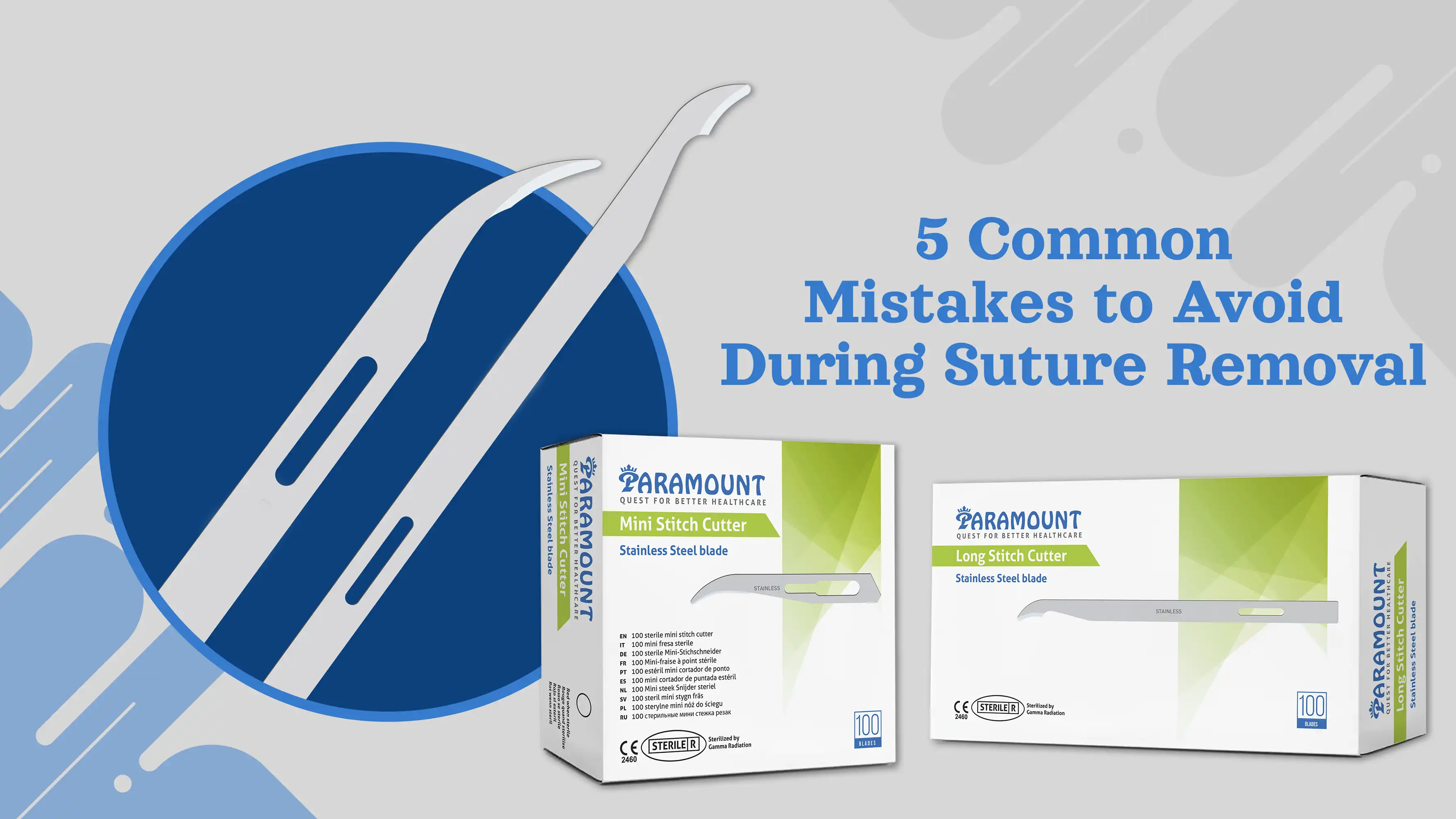Suture removal is one of the most common yet delicate procedures in clinical practice. While it may appear simple, mistakes during suture removal can lead to patient discomfort, delayed healing, or even infection. That’s why using the right stitch cutter is essential for safe and efficient outcomes.
In this guide, we’ll explore five common mistakes to avoid during suture removal and how choosing the right tool – such as a sterile disposable stitch cutter – makes all the difference for healthcare providers, hospitals, and global distributors.
What Is a Stitch Cutter?
A stitch cutter is a small, sharp device designed specifically for cutting and removing sutures. It consists of a stainless-steel or carbon-steel blade, sterilized by gamma radiation (minimum 25 kGy) to ensure sterility for up to five years
Common types include:
- Long stitch cutter
- Short stitch cutter
- Mini stitch cutter (used with BP handle as per ISO 7740)
- Stitch cutter with handle
These devices are single-use only and are supplied sterile in peel-apart aluminum pouches.
5 Common Mistakes to Avoid During Suture Removal
1. Reusing Stitch Cutters
Reusing a disposable surgical stitch cutter is a major risk. It can act as a carrier for communicable diseases such as HIV, Hepatitis, and other infections.
Better Practice: Always use a disposable stitch cutter blade for single-use only. Global distributors can highlight this as a key selling point when supplying to hospitals and clinics.
2. Ignoring Expiry Dates
Every sterile stitch cutter has a 5-year expiry period. Using the device beyond its expiry compromises sterility and blade sharpness.
Better Practice: Distributors should train buyers to check the expiry date and intact packaging before use.
3. Incorrect Size Selection
Using the wrong size – long vs. short vs. mini – may result in poor handling or incomplete suture removal.
Better Practice: Stock all variants of stitch cutters (long, short, mini) to ensure surgeons always have the right tool.
4. Improper Handling and Grip
During removal, the blade tip should slide flat under the suture and be rotated gently to cut. Incorrect handling can cause deep cuts, patient pain, or wound contamination.
Better Practice: The ergonomic design of Paramount’s stitch cutter with handle provides a steady grip and prevents accidental injury.
5. Unsafe Disposal Practices
Improper disposal of used stitch cutters increases the risk of sharps injuries.
Better Practice: After each use, discard the cutter in a bio-medical sharps container as per country regulations.
How the Right Stitch Cutter Solves These Problems
Key Features of a Reliable Stitch Cutter
- Sterilized by Gamma Radiation (25 kGy minimum)
- Stainless steel or carbon steel blade for sharpness and precision
- Packed in peel-apart aluminum pouch with VCI liner (prevents corrosion)
- Available in multiple sizes for flexible clinical use
- Single-use sterile device (5-year shelf life)
- Globally compliant manufacturing (ISO 13485, CE, FDA standards)
These features not only ensure safety and patient comfort but also give distributors confidence in promoting a trusted global brand.
Stitch Cutter Uses in Healthcare
- General suture removal in hospitals and clinics
- Post-surgical wound management
- Dermatology and minor surgeries
- Paramedical care centers
Why Stitch Cutters Are a Profitable Product for Distributors
For importers and distributors, stitch cutters are high-demand, fast-moving surgical disposables that deliver:
- ✅ Low cost, high turnover product
- ✅ Strong margins on bulk orders
- ✅ Easy inventory management (sterile, long shelf life)
- ✅ Compliance-ready devices trusted in 97+ countries
Paramount Surgimed Limited supplies stitch cutters at scale with global certifications, ensuring buyers benefit from reliable quality and timely delivery.
How to Remove Stitches with a Stitch Cutter?
To remove sutures safely:
- Hold the free end of the suture.
- Slide the stitch cutter blade flat against the skin under the suture.
- Rotate gently so the edge cuts the suture close to where it enters the skin.
- Pull the suture out without dragging external parts through the wound (to prevent infection).
- Discard the disposable stitch cutter immediately after use
FAQ – Stitch Cutters Explained
Q: What is a stitch cutter used for?
A stitch cutter is a sterile tool designed to cut and remove sutures after surgery.
Q: Can I reuse a disposable stitch cutter?
No. Reuse can transmit diseases and blunt the blade. Always discard after single use.
Q: How to remove stitches with a stitch cutter?
Gently slide the blade tip under the suture, rotate to cut, and pull the suture out safely.
Q: What sizes are available?
Long, short, mini (for use with BP handle), and stitch cutters with handle.
Q: Why should distributors stock stitch cutters?
They are low-cost, high-demand products with global certifications and strong margins.
Conclusion: Safer Suture Removal with Trusted Tools
Avoiding mistakes during suture removal is simple when the right tool is used. A sterile disposable stitch cutter ensures sharpness, safety, and sterility, reducing risks for patients and healthcare staff.
For distributors, stitch cutters are an essential product line with strong market demand and compliance-ready certifications.
Looking to supply sterile disposable stitch cutters globally?
Trust Paramount Surgimed Limited – your partner for certified, high-quality surgical disposables.

